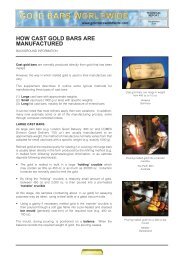Indian Gold Book:Indian Gold Book - Gold Bars Worldwide
Indian Gold Book:Indian Gold Book - Gold Bars Worldwide
Indian Gold Book:Indian Gold Book - Gold Bars Worldwide
Create successful ePaper yourself
Turn your PDF publications into a flip-book with our unique Google optimized e-Paper software.
PRICING AND PROFITABILITY<br />
GOLD JEWELLERY<br />
JEWELLERY FABRICATORS<br />
Contracts<br />
Where retailers and wholesalers do not undertake their fabrication in-house, they enter into a contract with one or more<br />
independent fabrication units.<br />
Most fabrication by these units is undertaken on the basis that retailers and wholesalers, and the public if they deal<br />
directly with them, supply the required amount of gold. The prevailing gold price is usually irrelevant to the transaction.<br />
The units normally cover their costs in one of 3 ways. The agreed charges vary according to the category, weight,<br />
complexity and quality of the item, although some fabricators may charge the same (or similar) rate per gramme for all<br />
designs if they specialise in a specific category and style.<br />
In the form of retained gold<br />
Under this system, fabricators return gold jewellery to an agreed weight, caratage and solder content, retaining an agreed<br />
percentage of the fine gold content to cover the wastage and labour charges. Where this occurs, the percentage retained<br />
tends to range between 4 - 10 %.<br />
In the form of retained gold plus labour charges<br />
Under this system, wastage and the labour charges are negotiated separately. For example, wastage might be 4% and the<br />
labour charge Rs 15 per gramme.<br />
In the form of labour charges only<br />
In recent years, many top end retailers and wholesalers now require fabricators to take responsibility for the wastage<br />
factor. Instead, they pay a higher labour charge (inclusive of wastage), normally in rupees per gramme.<br />
This system has grown among top end retailers as a result of the use of cadmium (it evaporates under heat after<br />
fabrication) or high caratage solders, access to more sophisticated assaying procedures and assay centres, the need to<br />
upgrade caratages since hallmarking was first mooted in the late 1990s, and a motivation to reduce their costs.<br />
Under this system, they expect to receive jewellery containing the same amount of fine gold supplied. The higher labour<br />
charge tends to range between Rs 25 - 50 per gramme, but can be more for complicated items.<br />
Indicative fabrication costs to retailers<br />
The schedule below illustrates the relative charges (inclusive of wastage and labour costs) incurred by a top end retailer for<br />
different categories of standard items. It does not imply that these charges are standard. They would vary according to<br />
the complexity of the items.<br />
Item Handmade<br />
Rs per gramme US$ per gramme<br />
Necklace 35 0.70<br />
Bangle 30 0.60<br />
Chain 45 0.90<br />
Earring 45 0.90<br />
Ring 35 0.70<br />
Generally, a top end retailer would expect average fabrication costs to be around 8 - 10% above the value of the prevailing<br />
gold price.<br />
Profitability<br />
Independent fabrication units are generally regarded as low profit enterprises. Most have also seen their incomes and<br />
profits decline for two reasons, apart from the pressure of increasing competition.<br />
Where gold retention is part or the entire source of income, they have been squeezed by a rupee gold price that has been<br />
largely static in recent years.<br />
The trend among top end retailers to pay labour charges only (permitting no wastage) has also reduced a fabrication unit’s<br />
profitability. The labour charge tends not to cover the previous wastage charge in full. The unit is also often obliged to use<br />
additional gold from its own inventory to provide sufficient feedstock to fabricate the required items.<br />
For example, in Kolkata, it is reported that about 5 years ago, the system was typically 6.5% wastage (Rs 30) plus a labour<br />
charge of Rs 6 per gramme. Total: Rs 36 per gramme. Many units are now receiving around Rs 25 - 30.<br />
The income of employed goldsmiths and ancillary workers is generally low. Wages are reported to range between Rs 4,000<br />
- 15,000 (US$ 80 - 300) per month.<br />
156<br />
AN INTRODUCTION TO THE INDIAN GOLD MARKET

















